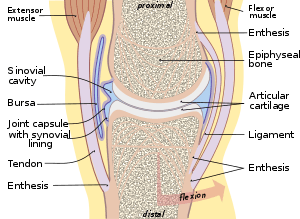Enthesis
The enthesis (plural entheses) is the connective tissue between tendon or ligament and bone.[1]
| Enthesis | |
|---|---|
 Typical Joint | |
| Identifiers | |
| TH | H3.03.00.0.00034 |
| Anatomical terminology | |
There are two types of entheses: Fibrous entheses and fibrocartilaginous entheses.[2][3]
In a fibrous enthesis, the collagenous tendon or ligament directly attaches to the bone.
In a fibrocartilaginous enthesis, the interface presents a gradient that crosses four transition zones:[4]
- Tendinous area displaying longitudinally oriented fibroblasts and a parallel arrangement of collagen fibres
- Fibrocartilaginous region of variable thickness where the structure of the cells changes to chondrocytes
- Abrupt transition from cartilaginous to calcified fibrocartilage—often called 'tidemark' or 'blue line'
- Bone
Clinical significance
A disease of the entheses is known as an enthesopathy or enthesitis.[5]
Enthetic degeneration is characteristic of spondyloarthropathy and other pathologies.
The enthesis is the primary site of disease in ankylosing spondylitis.
Society and culture
Bioarchaeology
Entheses are widely recorded in the field of bioarchaeology where the presence of anomalies at these sites, called entheseal changes, has been used to infer repetitive loading to study the division of labour in past populations.[6] Several different recording methods have been proposed to record the variety of changes seen at these sites.[7][8][9][10][11][12][13][14] However, research has shown that, whichever recording method is used, entheseal changes occur more frequently in older individuals.[15][8][16][17][18] Research demonstrates that diseases, such as ankylosing spondylitis and calcific tendinitis,[19] also have to be taken into consideration.
History
"Enthesis" is rooted in the Ancient Greek word, "ἔνθεσις" or "énthesis," meaning “putting in," or "insertion." This refers to the role of the enthesis as the site of attachment of bones with tendons or ligaments. Relatedly, in muscle terminology, the insertion is the site of attachment at the end with predominant movement or action (opposite of the origin). Thus the words (enthesis and insertion [of muscle]) are proximal in the semantic field, but insertion in reference to muscle can refer to any relevant aspect of the site (i.e., the attachment per se, the bone, the tendon, or the entire area), whereas enthesis refers to the attachment per se and to ligamentous attachments as well as tendinous ones.
See also
References
- "enthesis". Medcyclopaedia. GE. Archived from the original on 2012-02-05.
- Thomopoulos, Stavros; Birman, Victor; Genin, Guy, eds. (2012). Structural Interfaces and Attachments in Biology. New York: Springer. ISBN 9781461433163.
- Rothrauff BB, Tuan RS (2014). "Cellular therapy in bone-tendon interface regeneration". Organogenesis. 10 (1): 13–28. doi:10.4161/org.27404. PMC 4049890. PMID 24326955.
- Genin, Guy; Thomopoulos, Stavros (2017). "The tendon-to-bone attachment". Nature Materials. 16 (6): 607–608. doi:10.1038/nmat4906. PMC 5575797. PMID 28541313.
- Benjamin, M.; Toumi, H.; Ralphs, J. R.; Bydder, G.; Best, T. M.; Milz, S. (April 2006). "Where tendons and ligaments meet bone: Attachment sites ('entheses') in relation to exercise and/or mechanical load". Journal of Anatomy. 208 (4): 471–90. doi:10.1111/j.1469-7580.2006.00540.x. PMC 2100202. PMID 16637873.
- Jurmain, Robert; Cardoso, Francisca Alves; Henderson, Charlotte; Villotte, Sébastien (2011-01-01). Grauer, Anne L. (ed.). A Companion to Paleopathology. Wiley-Blackwell. pp. 531–552. doi:10.1002/9781444345940.ch29. ISBN 9781444345940.
- Hawkey, Diane E.; Merbs, Charles F. (1995-12-01). "Activity-induced musculoskeletal stress markers (MSM) and subsistence strategy changes among ancient Hudson Bay Eskimos". International Journal of Osteoarchaeology. 5 (4): 324–338. doi:10.1002/oa.1390050403. ISSN 1099-1212.
- Henderson, C. Y.; Mariotti, V.; Pany-Kucera, D.; Villotte, S.; Wilczak, C. (2013-03-01). "Recording Specific Entheseal Changes of Fibrocartilaginous Entheses: Initial Tests Using the Coimbra Method". International Journal of Osteoarchaeology. 23 (2): 152–162. doi:10.1002/oa.2287. hdl:10316/44423. ISSN 1099-1212.
- Henderson, C. Y.; Mariotti, V.; Pany-Kucera, D.; Villotte, S.; Wilczak, C. (2016-09-01). "The New 'Coimbra Method': A Biologically Appropriate Method for Recording Specific Features of Fibrocartilaginous Entheseal Changes". International Journal of Osteoarchaeology. 26 (5): 925–932. doi:10.1002/oa.2477. hdl:10316/44421. ISSN 1099-1212.
- Valentina, Mariotti; Fiorenzo, Facchini; Maria, Giovanna Belcastro (2004-06-15). "Enthesopathies – Proposal of a Standardized Scoring Method and Applications". Collegium Antropologicum. 28 (1). ISSN 0350-6134.
- Valentina, Mariotti; Fiorenzo, Facchini; Giovanna, Belcastro, Maria (2007-01-04). "The Study of Entheses: Proposal of a Standardised Scoring Method for Twenty-Three Entheses of the Postcranial Skeleton". Collegium Antropologicum. 31 (1). ISSN 0350-6134.
- Villotte, Séb. "Practical protocol for scoring the appearance of some fibrocartilaginous entheses on the human skeleton". Cite journal requires
|journal=(help) - Villotte, Sébastien; Castex, Dominique; Couallier, Vincent; Dutour, Olivier; Knüsel, Christopher J.; Henry-Gambier, Dominique (2010-06-01). "Enthesopathies as occupational stress markers: Evidence from the upper limb". American Journal of Physical Anthropology. 142 (2): 224–234. doi:10.1002/ajpa.21217. ISSN 1096-8644. PMID 20034011.
- Villotte, Sébastien; Assis, Sandra; Cardoso, Francisca Alves; Henderson, Charlotte Yvette; Mariotti, Valentina; Milella, Marco; Pany-Kucera, Doris; Speith, Nivien; Wilczak, Cynthia A. (2016-06-01). "In search of consensus: Terminology for entheseal changes (EC)" (PDF). International Journal of Paleopathology. 13: 49–55. doi:10.1016/j.ijpp.2016.01.003. PMID 29539508.
- Cardoso, F. Alves; Henderson, C. (2013-03-01). "The Categorisation of Occupation in Identified Skeletal Collections: A Source of Bias?". International Journal of Osteoarchaeology. 23 (2): 186–196. doi:10.1002/oa.2285. hdl:10316/21142. ISSN 1099-1212.
- Michopoulou, Efrossyni; Nikita, Efthymia; Valakos, Efstratios D. (2015-12-01). "Evaluating the efficiency of different recording protocols for entheseal changes in regards to expressing activity patterns using archival data and cross-sectional geometric properties". American Journal of Physical Anthropology. 158 (4): 557–568. doi:10.1002/ajpa.22822. ISSN 1096-8644. PMID 26239396.
- Milella, Marco; Giovanna Belcastro, Maria; Zollikofer, Christoph P.E.; Mariotti, Valentina (2012-07-01). "The effect of age, sex, and physical activity on entheseal morphology in a contemporary Italian skeletal collection". American Journal of Physical Anthropology. 148 (3): 379–388. doi:10.1002/ajpa.22060. ISSN 1096-8644. PMID 22460619.
- Henderson, C. Y.; Mariotti, V.; Santos, F.; Villotte, S.; Wilczak, C. A. (2017-06-20). "The new Coimbra method for recording entheseal changes and the effect of age-at-death". BMSAP. 29 (3–4): 140–149. doi:10.1007/s13219-017-0185-x. hdl:10316/44430. ISSN 0037-8984.
- Henderson, C.Y. (2013). "Do diseases cause entheseal changes at fibrous entheses?". International Journal of Paleopathology. 3 (1): 64–69. doi:10.1016/j.ijpp.2013.03.007. hdl:10316/44415. PMID 29539362.
External links
- Enthesis information site at www.enthesis.info
- Image of enthesis at Medscape
- Enthesopathy and Soft Tissue Shadows at chiroweb.com
Further reading
- Resnick D, Niwayama G (1983). "Entheses and enthesopathy. Anatomical, pathological, and radiological correlation". Radiology. 146 (1): 1–9. doi:10.1148/radiology.146.1.6849029. PMID 6849029.